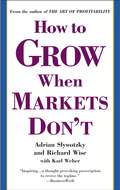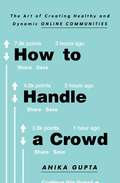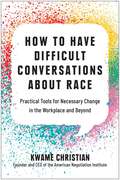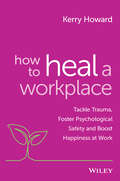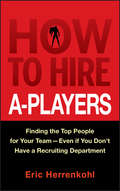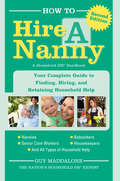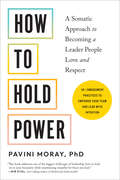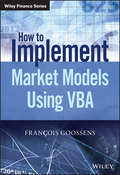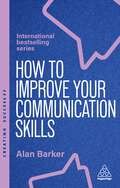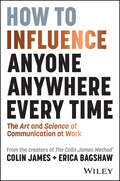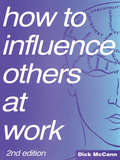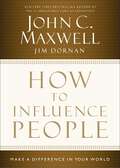- Table View
- List View
How to Grow when Markets Don't
by Karl Weber Adrian Slywotzky Richard WiseProgressive Insurance, GE Medical Systems, and John Deere Landscapes are enjoying astonishing new revenue growth while leaving their competition behind. How to Grow When Markets Don't reveals the secret behind the biggest business successes in a very tough economic climate. Discover the dynamic new strategy known as "demand innovation," which can be adapted by any company in any industry, and watch your profits soar. What does a check-printing company do when fewer people write checks? Clarke American applied a dynamic new business approach that resulted in double-digit growth. What happens when a breakthrough technology is threatened by copycat competitors? Innovative thinking saved GM's OnStar and achieved stratospheric revenues.
How to Grow your Own Money
by David MeckinNobody cares more about your money than you do. And no one delivers financial advice in a no-nonsense, straight-to-the-point style like David Meckin. The author of Naked Finance advises a new wave of financial investors--the refugees of the great Recession who, disgruntled by the reckless advice given to them by salesmen thinly disguised in financial advisors' clothing, are cutting out the middleman and investing their money themselves. In the process they're saving money by eliminating unnecessary fees. Whether you have a large sum of money or a modest amount to allocate, taking control of your investments is not as difficult or time-consuming as some financial services companies would have you believe. But it does require a bit of practical guidance and the objective, hard-won insights of someone with a strong financial background like Meckin--himself a highly successful independent investor. How to Grow Your Own Money is an accessible guide that shows how you can get an edge on the market. It includes the four main investment opportunities available to the independent investor: savings accounts, government and corporate bonds, stocks, and real estate. You'll learn the tried and tested techniques you'll need to build the skills, confidence, and know-how to grow and maximize your returns. You'll learn Meckin's tried and tested Winning Six approach: a step-by-step methodology that can be applied to any investment opportunity. Stop dreaming about being an independent investor and start doing it today.
How to Handle a Crowd: The Art of Creating Healthy and Dynamic Online Communities
by Anika GuptaA guide to successful community moderation exploring everything from the trenches of Reddit to your neighborhood Facebook page. Don&’t read the comments. Old advice, yet more relevant than ever. The tools we once hailed for their power to connect people and spark creativity can also be hotbeds of hate, harassment, and political division. Platforms like Facebook, YouTube, and Twitter are under fire for either too much or too little moderation. Creating and maintaining healthy online communities isn&’t easy. Over the course of two years of graduate research at MIT, former tech journalist and current product manager Anika Gupta interviewed moderators who&’d worked on the sidelines of gamer forums and in the quagmires of online news comments sections. She&’s spoken with professional and volunteer moderators for communities like Pantsuit Nation, Nextdoor, World of Warcraft guilds, Reddit, and FetLife. In How to Handle a Crowd, she shares what makes successful communities tick – and what you can learn from them about the delicate balance of community moderation. Topics include: -Building creative communities in online spaces -Bridging political division—and creating new alliances -Encouraging freedom of speech -Defining and eliminating hate and trolling -Ensuring safety for all participants- -Motivating community members to action How to Handle a Crowd is the perfect book for anyone looking to take their small community group to the next level, start a career in online moderation, or tackle their own business&’s comments section.
How to Have Difficult Conversations About Race: Practical Tools for Necessary Change in the Workplace and Beyond
by Kwame ChristianIf we want a more equitable workplace—and a more equitable world—we have to talk to each other about race. But, for so many of us, that&’s easier said than done. When we avoid conversations about race, it&’s often because of fear: fear of discomfort, or of damaging important relationships; fear of being misunderstood, &“canceled,&” ostracized. Negotiation expert Kwame Christian&’s motto is: "The best things in life are on the other side of difficult conversations." How to Have Difficult Conversations About Race equips you with the skills you need to make these crucial conversations both easier and more productive. You&’ll not only gain the confidence to talk about race, but also learn how to actually make a difference when you do. Whether you&’re looking to create change for yourself and other BIPOC, or are a white ally seeking to support your coworkers or clients, you&’ll learn how to: Overcome your internal barriers to talking about diversity, equity, and inclusion (DEI). Work around others&’ barriers to productive discussion. Be strategic about the outcome you want and guide the conversation accordingly. Use &“Compassionate Curiosity&” to connect and persuade. Avoid common mistakes. Tackle some of the most common race-related conversations that come up in the workplace. If you&’ve ever struggled to turn your passion for change into persuasion or been too afraid to speak up at work (or outside of it), this book is for you. The first step toward lasting social change is productive discussion. With How to Have Difficult Conversations About Race, you&’ll never shy away from those crucial conversations again.
How to Have a Good Day: Harness the Power of Behavioral Science to Transform Your Working Life
by Caroline WebbIn How to Have a Good Day, economist and former McKinsey partner Caroline Webb shows readers how to use recent findings from behavioral economics, psychology, and neuroscience to transform our approach to everyday working life. Advances in these behavioral sciences are giving us ever better understanding of how our brains work, why we make the choices we do, and what it takes for us to be at our best. But it has not always been easy to see how to apply these insights in the real world - until now. In How to Have a Good Day, Webb explains exactly how to apply this science to our daily tasks and routines. She translates three big scientific ideas into step-by-step guidance that shows us how to set better priorities, make our time go further, ace every interaction, be our smartest selves, strengthen our personal impact, be resilient to setbacks, and boost our energy and enjoyment. Through it all, Webb teaches us how to navigate the typical challenges of modern workplaces--from conflict with colleagues to dull meetings and overflowing inboxes--with skill and ease. Filled with stories of people who have used Webb's insights to boost their job satisfaction and performance at work, How to Have a Good Day is the book so many people wanted when they finished Nudge, Blink and Thinking Fast and Slow and were looking for practical ways to apply this fascinating science to their own lives and careers. A remarkable and much-needed book, How to Have a Good Day gives us the tools we need to have a lifetime of good days.From the Hardcover edition.
How to Have a Great Career: Find Your Passion, Achieve Your Goals, Love What You Do
by Larry SmithOver the past three decades, professor Larry Smith has become something of a “career whisperer” for his students at the University of Waterloo. Each year, millions of talented college and university students graduate with little or no real sense of what their next step will be, yet they are determined not to settle for so-so careers; they are looking for great careers. Smith points out that only a few fortunate souls are born knowing exactly what they want to pursue in life. The rest of us have to stop making excuses and start asking ourselves tough questions about achieving our goals.In his straightforward, no-nonsense approach, Smith itemizes and dismisses all the usual excuses, fears and worries that people hide behind when trying to find their true direction. His unusual take on this challenging conundrum is both universal and timely, and his stunning TEDx talk on this subject has been viewed by more than six million people so far.This is the perfect book for all college graduate who are wondering where they fit into the world, or for mid-career men and women who find themselves heading down the wrong path. It won't necessarily be easy, but if you follow Smith’s guidance, your career dreams can indeed come true.
How to Have a Great Life: 35 Surprisingly Simple Ways to Success, Fulfillment and Happiness
by Paul McGee35 ways to success, fulfillment, and happiness How to Have a Great Life starts with you–your strengths and amazing potential and how to develop those. It helps you understand how to tap into your ability to grow, while equipping you with insights, inspiration, and practical tools to deal with whatever life throws your way in order to achieve success and live a happy and fulfilled life. You already have many of the tools you need to succeed–you just need to know which ones to use and how best to use them. With no-frills, funny, and emotionally intelligent advice, Paul McGee will make you think, make you laugh, and make you take action to live your greatest life possible. Tap into your ability to grow Find insight and practical tools to deal with whatever life throws your way Slow down and live a more balanced life Re-gain time and brain space Improve the quality of your relationships with others We are living faster and more frantic lives than ever before—and there’s no time like the present to catch your breath and live your best life possible.
How to Have a Stress Free Mortgage: Insider Tips From a Certified Mortgage Broker to Help Save You Time, Money, and Frustration
by Linda FleischmannHow to Have a Stress Free Mortgage is your resource to getting a loan in today’s market. It will guide you through the traps to avoid before you start house hunting or begin to consider a refinance. Forget about what you may have heard by “supposed” experts; Linda Fleischmann is an active Mortgage Broker and she is in the trenches closing loans. After more than 13 years, Linda knows what to do to get you a loan. Use "How to Have a Stress Free Mortgage" as source for getting a mortgage loan today! Here are just a few things that you will learn: What type of loan should you choose? How much do you need to save for a down payment…is it really 20%? When can you buy again if you’ve had a foreclosure or short sale? Can you have too much credit? Should you co sign for a car loan? What you don’t know can hurt you and more importantly, might stop you from getting into your dream home. If just thinking about applying for a mortgage loan makes you queasy or stressed, then you need to read "How to Have a Stress Free Mortgage" today. Knowing up front what to do BEFORE you apply is critical to getting your loan approved. "How to Have a Stress Free Mortgage" will take you through all of the steps of the loan process so you will understand what is happening, why it’s happening and make you stress free from start to finish.
How to Have an Epic Retirement
by Bec WilsonMore than 500,000 Australians plan to retire in the next five years and are in their pre-retirement or 'part-time' retirement years, preparing for the massive life change that signals their move from working every day to living as they choose. In the years before they retire, and the early years of retirement, people want to prepare well and set themselves up for the exciting 30+ year journey that could be ahead of them. This is where How to Have an Epic Retirement comes in. There is no one in Australia who has more insight into what retirees want and what they need to know to achieve it than Rebecca Wilson, founder of the hugely successful online platform Starts at 60. Armed with information and the best anecdotal knowledge from retirees and those planning to retire, Rebecca has compiled the ultimate guidebook for those who want to make the most of this time of their lives. With examples, common questions and information you can apply to your own circumstances, Rebecca addresses the six key pillars of a great retirement: time, money, health, happiness and fulfilment, travel and your home. How to Have an Epic Retirement guides readers through the way the systems of retirement work, so you can learn the valuable lessons that modern retirees wish someone had shared with them before they kicked off the changes and stages of life that come after retirement. Every modern retiree can have an Epic Retirement - and this book will show you how.
How to Heal a Workplace: Tackle Trauma, Foster Psychological Safety and Boost Happiness at Work
by Kerry HowardBoost wellbeing and build a robust, productive culture in your workplace Your workplace’s most powerful resource is its people. That’s why it’s critical to balance the needs of your business with the needs of the employees who make that business happen every day. At the heart of the matter is your workplace culture: the environments and relationships that shape your business, whether physical or virtual. How to Heal a Workplace shares the insights and hands-on advice that you need to better understand how your culture impacts your team. You’ll learn how to manage interpersonal challenges—and anticipate the impact of policies and procedures—to create a healthier, happier and more productive environment. Drawing on real-world stories from diverse industries, in-demand workplace mental health consultant Kerry Howard shares strategies that will help you: Boost employee wellbeing, and attract and retain staff by supporting their mental health Understand how trauma is caused by everyday events and how this impacts the workplace Combat bullying and harassment and prevent workplace injuries Foster psychological safety, improve communication, and build better relationships between colleaguesIn How to Heal a Workplace, you’ll find the practical advice you need to create a better culture, improve productivity and increase satisfaction across every area of your business.
How to Hedge Metals: A Complete Guide to Hedging for Companies that Produce, Consume, and Trade Physical Metals
by Lesley CampbellHow to Hedge Metals is an important resource for all traders, whether new graduates or seasoned directors, and is written in simple, precise, and clear terms. It is engaging and accessible – a good read rather than a reference book – and provides solutions to the problems caused by metal price volatility. It walks through the entire hedging process, starting long before the first futures trade, with a discussion on risk tolerance and appetite. It explains how the world’s major futures exchanges work; but more importantly, it explains how futures and options can solve physical trading problems. Written entirely from a hedger’s perspective, How to Hedge Metals answers questions on issues such as Quotational Periods, option premiums, and backwardations. The aim of the book is not to promote hedging; some companies will learn how to minimise risk by changing their physical contracts, while others may conclude that the level of risk they face is acceptable. For those who decide to hedge there is a step-by-step guide to preparation, implementation, and evaluation of a hedging strategy, as well as case studies to illustrate how strategies have gone wrong in the past. Whatever their business model and knowledge of commodity markets, metal producers, fabricators and traders will understand what they can realistically achieve with a hedging program, and how to achieve it. This book deals with real world problems – contracts that are not in convenient 25 tons multiples, customers, and suppliers who change their minds, shipments that are delayed and markets that inexplicably move in ways that seem to defy the laws of supply and demand. Written by a respected industry expert who has worked for trading companies, banks, brokers, and the London Metal Exchange (LME), it uses simple language and engaging graphics to show how futures and options can offer protection from the increasing volatility of metal prices.
How to Help Your Husband Make More Money so You Can Be a Stay-at-Home Mom
by Joanne WatsonThe author shares the techniques and secrets she used to help her husband make more money. Providing information on how a wife can help her husband boost his income, this is the guide book for those women dreaming of being a stay-at-home mom.
How to Hire A-Players
by Eric HerrenkohlHow to find great employees, make great hires, and take your business to the next level It is always easy to find people who want a job, but it's never easy to find and hire A-players. In How to Hire A-Players, consultant Eric Herrenkohl shows owners, executives, and managers of small and medium-size businesses where and how to find A-player employees. It is these individuals who will help keep quality high and growth and profits strong. Herrenkohl explains how to use your existing marketing, sales, and networking efforts to find top candidates. He provides current examples of companies that consistently hire A-players without big recruiting departments as well as step-by-step explanations for making these strategies work in your own company. Shows you how to find and hire top employees. Ideal for owners of small businesses, executives and managers of large businesses, as well as corporate recruiters and HR specialists who need new ideas Herrenkohl's client list includes privately held businesses in over 50 industries as well as big corporate names like Bank of America, Edward Jones, and Northwestern Mutual Life A-player employees are the life blood of any growing business. This handy hiring guide shows you where to look, what to ask, and who to hire to boost your business today
How to Hire a Nanny
by Guy MaddaloneFor more than 25 years, Guy Maddalone and his company, GTM Household Employment Experts, have assisted countless families with finding the right help to meet their needs. In How to Hire a Nanny, Guy passes on the same invaluable advice he's given to his clients. Readers will find information on how to hire, manage, and retain household employees, as well as sample interview questions, offer letters, and job descriptions. This new edition will feature updated information on employment laws and the best practices for finding help online.
How to Hit a Curveball
by Mark Levine Scott R. Singer"None of us knows what the future holds. But once you've learned how to confront and overcome the unexpected, this lack of knowledge will cease to make you anxious. Tomorrow will no longer be something to fear. And believe me, that's a great feeling" As a professional, you want to be ready for anything. You'll spend hours, days, even years, perfecting your technique, studying the competition and stepping up to challenges in order to make yourself an all-star. But at some point in your life, regardless of what you do or how far up the ladder you've climbed, you will be thrown a curveball-an unexpected challenge that comes at you quickly and without warning. The kind that forces you to rethink, well, everything. Whether it's the loss of a job, a newly assigned responsibility at work, or a global recession that threatens your entire company or industry, an unanticipated change can knock even the most experienced among us off guard. So if you want to succeed in business-and in life-it's not enough to be the smartest in the room or even the hardest working; you have to be a great curveball hitter. Investment banker Scott R. Singer learned this lesson the hard way. But after a series of career challenges and personal setbacks, he started to develop a new approach to dealing with unforeseen problems by adopting a new attitude toward life. He realized that curveballs are a part of the game and the greatest players know how to knock them out of the park. Singer shares his personal story and insights as well as those of some prominent curveball hitters he interviewed, such as Leslie Moonves of CBS, Alan Schwartz of Bear Stearns, and actor Michael J. Fox. Singer's rules for surviving and thriving when faced with uncertainty include: Step up to the plate: Accept what's happened; don't fight it. Tell others right away, and let them help. Be the batter, not the ball: Don't let your imagination get the best of you. Be a realist, not a pessimist. Keep your eye on the ball: Focus on what you can do instead of worrying about what might happen or what's beyond your control. This fun yet practical book is full of valuable advice and anecdotes that can help anyone avoid striking out at work (or at home) and maybe even turn those surprising challenges into tremendous opportunities. Visit www.hitacurveball.com
How to Hold Power: A Somatic Approach to Becoming a Leader People Love and Respect--30+ embodiment practices to empower your team and lead with intention
by Pavini MorayEssential skills for today's leaders: learn how to embody your ethics, earn your team's trust, and dismantle toxic work cultureLeaders and managers everywhere are learning the importance of creating safe, satisfying workplaces rooted in principles of social justice. But many of us who try to lead with ethics and integrity struggle with embracing a position of power and authority. You might worry about &“being bossy,&” unintentionally disrespecting others, or making the wrong call—and in the process, put your mind and body under so much stress that you burn out.Somatic educator and coach Pavini Moray argues that the secret to being an ethical, inspirational boss is rooted in our own bodies. In more than 30 simple exercises, reflections, and daily practices, you&’ll learn how to:Nurture trust with clients and coworkersGround and re-center when you&’re thrown off by a mistake or problemSoothe the &“Ouch!&” of negative feedbackBreak away from grind and hustle cultureTurn workplace conflict into a source of positive change and growthHelp your employees voice their own needs and feel heardUnderstand the nuances of consent beyond contract negotiationsGracefully acknowledge mistakesRepair relationships with employees, colleagues, and clientsDrawing from client case studies and their own experience as a manager, Moray teaches foundational embodiment practices—breath, grounding, observing, centering, and moving—through concrete examples that show how to use these skills in a variety of common workplace settings. By learning to practice embodied leadership presence, you can become a boss who truly listens to your employees; leads with inspiration; and brings your whole self to work every day.
How to Humble a Wingnut and Other Lessons from Behavioral Economics
by Cass SunsteinIn How to Humble a Wingnut, leading constitutional scholar, behavioral economist, and former Administrator of the White House Office of Information and Regulatory Affairs Cass R. Sunstein examines the unconventional impetuses behind human decision-making. Why it is that people often choose to behave so strangely? Sunstein's incisive commentaries point to recent empirical findings to demonstrate how and why people convince themselves they are right despite evidence to the contrary; fear dangers they are unlikely to encounter; and ignore real risks. Mining developments in recent behavioral studies for tips on everything from holiday shopping and political biases to staying healthy and clear thinking in general, Sunstein nudges his reader towards that rarest of grounds--understanding.
How to Implement Market Models Using VBA
by Francois GoossensAccessible VBA coding for complex financial modelling How to Implement Market Models Using VBA makes solving complex valuation issues accessible to any financial professional with a taste for mathematics. With a focus on the clarity of code, this practical introductory guide includes chapters on VBA fundamentals and essential mathematical techniques, helping readers master the numerical methods to build an algorithm that can be used in a wide range of pricing problems. Coverage includes general algorithms, vanilla instruments, multi-asset instruments, yield curve models, interest rate exotics, and more, guiding readers thoroughly through pricing in the capital markets area. The companion website (http://implementmodinvba.com/) features additional VBA code and algorithmic techniques, and the interactive blog provides a forum for discussion of code with programmers and financial engineers, giving readers insight into the different applications and customisations possible for even more advanced problem solving.. Financial engineers implement models from a mathematical representation of an asset's performance by building a program that performs a valuation of securities based on this asset. How to Implement Market Models Using VBA makes this technical process understandable, with well-explained algorithms, VBA code, and accessible theoretical explanations. Decide which numerical method to use in which scenario Identify the necessary building blocks of an algorithm. Write clear, functional VBA code for a variety of problems. Apply algorithms to different instruments and models . Designed for finance professionals, this book brings more accurate modelling within reach for anyone with interest in the market. For clearer code, patient explanation, and practical instruction, How to Implement Market Models Using VBA is an essential introductory guide.
How to Improve Your Communication Skills: How to Build Trust, Be Heard and Communicate With Confidence (Creating Success)
by Alan BarkerBetter communication skills will have a direct impact on your career development. Improve Your Communication Skills is your practical guide to effective communication in business.This fully updated 7th edition now features a handy self-assessment tool to help you profile your own preferred communication style, even more practical exercises, useful checklists and top tips, as well as content on influencing others and managing difficult conversations. This book provides vital guidance on improving your conversations, building rapport, giving effective presentations, writing excellent reports and networking successfully. With the help of Improve Your Communication Skills, you will be able to get your message across - every time.The Creating Success series of books...Unlock vital skills, power up your performance and get ahead with the bestselling Creating Success series. Written by experts for new and aspiring managers and leaders, this million-selling collection of accessible and empowering guides will get you up to speed in no time. Packed with clever thinking, smart advice and the kind of winning techniques that really get results, you'll make fast progress, quickly reach your goals and create lasting success in your career.
How to Induce Retailers to Reduce Stockouts?
by V. G. NarayananDescribes how the lack of incentive alignment between retailers and their vendors can lead to stockouts. Also describes various means to reduce incentive misalignment and hence stockouts.
How to Influence Anyone, Anywhere, Every Time: The Art and Science of Communication at Work
by Colin James Erica BagshawWe communicate all the time. But do we have impact? Do we influence? When you speak, do people lean in? When they hear you, do others feel impressed, challenged, motivated or inspired? Through tested frameworks and instantly applicable techniques, How to Influence Anyone, Anywhere, Every Time shows you how to use your words and your body language to engage and persuade. With this handbook, you'll learn crucial communication skills for delivering with impact in any professional setting — be it in the boardroom, your next sales meeting or interpersonal interactions. Master how to deliver your message with conviction, confidence and clarity. Globally renowned speaking coaches Colin James and Erica Bagshaw share their proven methodology for wielding influence in any and every context. In How to Influence Anyone, Anywhere, Every Time, they show you how to systematically get and hold people’s attention — and use your influence to achieve positive results in your organisation or business. Whether you’re working face-to-face, you need to create presence online, or you’re crafting a written message, you’ll discover the tips you need. Communicate more effectively with a tried-and-trusted process for success, using the 3 Ds: Diagnose: Who is your audience, what is the context and what is your desired outcome? Design: Get the magic 12 steps that make it easy to tailor your next communication to better engage and influence your audience. Deliver: Don't know what to do with your hands? Learn how to master body language, your voice, visual aids and even your energy for a delivery that will captivate, inspire and persuade even the toughest audience. How to Influence Anyone, Anywhere, Every Time is a must-have resource for anyone who needs to present their ideas, gain trust and bring about real change.
How to Influence Others at Work: Psychoverbal Communication For Managers
by Dick McCannBeing able to influence others is absolutely vital to the business manager who is not only responsible for their own destiny, but also the well-being of their staff and the future of their company. Getting people to do what you want them to has occupied the minds of generations of scholars, not to mention dictators. Among the former, the psychologist Carl Jung was perhaps the most prominent. His concepts of the extroverted and introverted personality, of archetypes and of the unconscious are now widely accepted. However, to understand and benefit properly from Jung, you need years of training. Fortunately though, Professor McCann has adapted Jung's ideas to the workplace and made them easy for us to understand. Not only that, in How to Influence Others at Work, he also combines his own remarkable techniques with those of neurolinguistics, resulting in an easy to digest volume which shows how all of us can use influence to our own ends.In this second edition the author has included a new chapter on communication channels. This chapter gives practical guidance on how to improve awareness in all aspects of communications.
How to Influence People: Make a Difference in Your World
by John Maxwell Jim DornanYou can make a difference! Believe it or not, the most effective way to make an impact on the world is to make an impact on individual people. How do you do that? Through influence. In How to Influence People, leadership guru John C.Maxwell and his friend Jim Dornan tell you how to make a positive impact on every person in your life, from your children and coworkers to your customers and the barista at the coffee shop. How to Influence People will empower you to become a potent and positive influence in the lives of those around you without using a position or title. By "pouring your life into other people" (Dr. Maxwell's definition of mentoring),"you can truly make a difference in their lives." And when you make a difference in the lives of others, it makes a difference in your life too.Learn to perceive the stages of influence in your relationships and skillfully navigate your progress from perfect stranger to helpful confidant, to inspiring mentor and multiplier of influencers. Let this book impact your relationships, great and small, and make you a positive influencer and better leader in the lives of those around you.
How to Interpret Data: Using Data to Improve Your Influence and Decision-making (Creating Success)
by Nicholas KellyThe best business decisions and strategies are always data-driven. Improve your understanding of data and your digital literacy with How to Interpret Data.Data is a cornerstone of our decision-making, but the ability to effectively interpret data is challenging to master. This book demystifies the process of data interpretation, providing you with the tools and knowledge you need to develop smart data-driven strategies.Packed full of fascinating interviews and stories which uncover the potential of data-driven strategies, this book will show you not only how to effectively interpret data, but will also uncover how you can use this knowledge to improve your decision-making and influence at work.
How to Invest Your Time Like Money
by Elizabeth Grace SaundersHow to Invest Your Time Like Money is a concise, practical guide to get you out of time debt. Unlike others, who create the false hope that if only you worked harder, faster, longer, and smarter, you could do everything you want and make everyone happy, time coach Elizabeth Grace Saunders introduces a process to better manage your limited time so you can focus on what's important. Her method will help you avoid letting everyday pressures and demands get in the way. Using proven techniques and exercises based on the principles of personal finance, readers will learn to identify their time debt, create a balanced budget, build a base schedule, maximize their time ROI, and identify a process to get back on track-and stay there.
